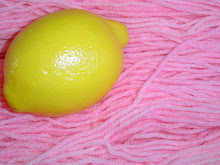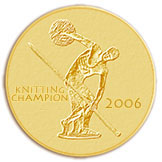How to knit two pieces at once
For this tutorial, I will be using the KnitPicks circular needle that I've knit the body of this sweater with. I'm doing that because I want my gauge to stay as close as possible to the same between the body and the sleeves. (Just knitting the body in the round and the sleeves flat is enough to cause gauge changes if I'm not careful.) It's entirely possible to do this on straight needles, and in fact, I recommend it on straights for your first time because it will eliminate the opportunity to turn the work before both items are worked (I'll explain farther down).
 To begin with, you'll need a set of straight needles or a circular needle (see above about starting with a pair of straights) and two balls of yarn. It's entirely possible to use one ball of yarn and work from both ends of the single ball, but that gets pretty twisty and irritating, so I prefer two separate balls.
To begin with, you'll need a set of straight needles or a circular needle (see above about starting with a pair of straights) and two balls of yarn. It's entirely possible to use one ball of yarn and work from both ends of the single ball, but that gets pretty twisty and irritating, so I prefer two separate balls. Using one ball of yarn, cast on the required number of stitches for one sleeve/one front. Use whichever cast on you prefer. I tend to use a long tail cast on for most things, but this sweater starts out with lace so I'm using a knitted on cast on which is more flexible. Notice that for this reason the yarn tail is on the left with the working yarn leading back to the ball on the right. (In a long tail cast on the yarn tail would be at the same end of the cast on stitches as the working yarn. The yarn tail doesn't matter and I will no longer discuss it, but I didn't want anyone to be confused by this cast on.) The most important part to note is that the working yarn is on the right at this point.
Using one ball of yarn, cast on the required number of stitches for one sleeve/one front. Use whichever cast on you prefer. I tend to use a long tail cast on for most things, but this sweater starts out with lace so I'm using a knitted on cast on which is more flexible. Notice that for this reason the yarn tail is on the left with the working yarn leading back to the ball on the right. (In a long tail cast on the yarn tail would be at the same end of the cast on stitches as the working yarn. The yarn tail doesn't matter and I will no longer discuss it, but I didn't want anyone to be confused by this cast on.) The most important part to note is that the working yarn is on the right at this point. Now, drop the working yarn from the first section you cast on. (I'm assuming you have double checked your counting and you have in fact cast on the correct number of stitches for whatever it is you're knitting at this point.) Make a slip knot with the yarn from the second ball and begin your cast on for the second sleeve/front.
Now, drop the working yarn from the first section you cast on. (I'm assuming you have double checked your counting and you have in fact cast on the correct number of stitches for whatever it is you're knitting at this point.) Make a slip knot with the yarn from the second ball and begin your cast on for the second sleeve/front. Once you've cast on the required number of stitches for the second sleeve/front, you will have something that looks like the picture above. Note that for each cast on unit the working yarn is on the right end of those stitches. I'm now ready to start knitting the sleeves. Once I work across the first sleeve, I will drop that working yarn and pick up the working yarn for the second sleeve (note that the first sleeve I knit on will be the second sleeve I cast on - don't overthink it, just knit). The most important thing to remember when knitting this way is NOT to turn your work between sleeves/fronts. Always knit a row on BOTH sides before turning your work and working back. If you're working with a pair of straight needles, you will only turn your work when both pieces of your knitting are on the right needle. It's the circular needles that are easy to get confused with. I use row counters when I knit and I always set it up so that odd numbered rows are right side rows. Being consistent with this, I can figure out which side isn't knit if I have to set down my knitting between pieces, before completing the row on both parts.
Once you've cast on the required number of stitches for the second sleeve/front, you will have something that looks like the picture above. Note that for each cast on unit the working yarn is on the right end of those stitches. I'm now ready to start knitting the sleeves. Once I work across the first sleeve, I will drop that working yarn and pick up the working yarn for the second sleeve (note that the first sleeve I knit on will be the second sleeve I cast on - don't overthink it, just knit). The most important thing to remember when knitting this way is NOT to turn your work between sleeves/fronts. Always knit a row on BOTH sides before turning your work and working back. If you're working with a pair of straight needles, you will only turn your work when both pieces of your knitting are on the right needle. It's the circular needles that are easy to get confused with. I use row counters when I knit and I always set it up so that odd numbered rows are right side rows. Being consistent with this, I can figure out which side isn't knit if I have to set down my knitting between pieces, before completing the row on both parts.
The benefits to knitting both sleeves/fronts at once are that I don't suffer from Second Sleeve/Front Syndrome, my gauge stays the same over both pieces (even if I'm stressed and knitting tighter one day, the tighter section will be on both parts, rather than one), and I'm more likely to get my shaping in the same place on both pieces. Most sleeves are identical, but cardigan fronts are mirror images of each other. It's easy to mirror the shaping with both halves of the front right next to each other - the space between the two fronts becomes the center space of the cardi.
Hopefully this will clear up any questions you might have had about how this works. Once you get everything cast on and start going, it's pretty easy to see how the whole thing works, but if you've never done it before, it can be easy to overthink and make it more complicated than it is.
Labels: Pullovers










7 Comments:
Nice tutorial. Very easy to follow!
Thanks for the detailed tutorial - it was very helpful. Happy knitting.
Great tutorial, Melanie, but I fear your Sesame Street education is sadly lacking when you refer to elephants and elevators. Go here and scroll down to the third-last track:
http://www.2007mp3.org/sesame_street_silly_songs/
:D
That makes perfect sense! I wonder why I couldn't figure that out?! Thanks so much for breaking it down for me and all the other curious knitters out there. I'll be bookmarking this page.
I may try this soon. And with my Knit Pick circs, I can use two cables with a cap on each end, to make them act like straight needles. I have always been worried about how you keep from knitting more rows on one that the other. But I am strictly a circs type of knitter. It makes a lot of sense now. Thanks
Thanks for the tutorial. I'm trying this tonight. I'm making my 3-year-old daughter a poncho type sweater with sock yarn. Going to work on the 2 front panels.
Thanks again.
Thanks so much for this great tutorial. I am knitting lace booties for a newborn friend's daughter and doing this for the first time on straights. I wanted to do them at the same time but wasn't sure how to. Great tutorial and worked out beautifully! Booties and soles are the same size. I will have to get a tutorial for doing the same thing on circulars! :)
Post a Comment
<< Home